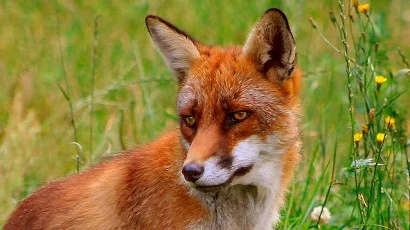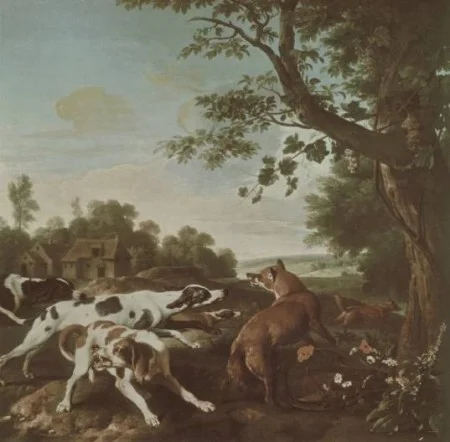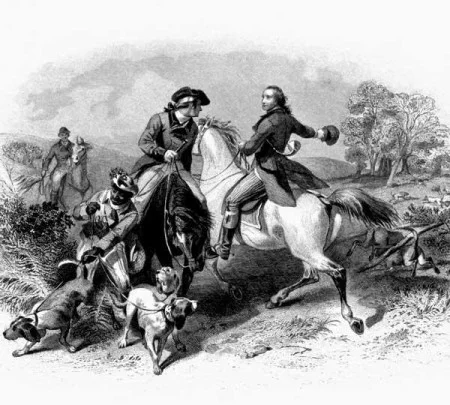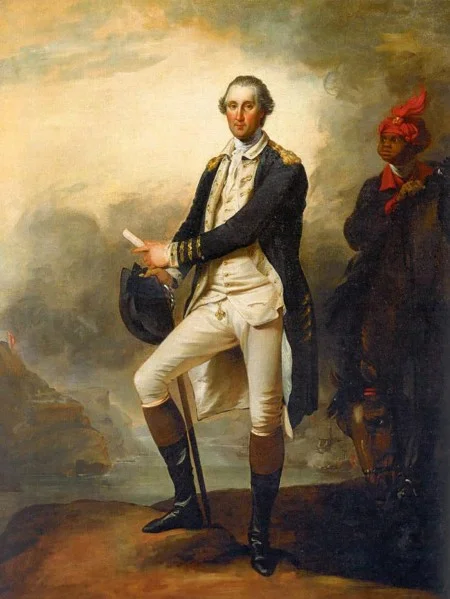Throughout his lifetime, George Washington enjoyed foxhunting during the fall and winter at Mount Vernon, often inviting his neighbors and business associates to join him.
In the 18th century, the sport of foxhunting became the rage for men of fashion, who took pleasure in jumping horses. What George Washington learned as a foxhunter about protocol and rough riding became invaluable to him later in life.

Foxhunting in the 18th Century
Foxhunting season began in the autumn with at least a half-dozen English foxhounds sniffing the fresh air, licking their snouts and jumping up and down, anticipating the thrill of a morning run through the fields and woods that stretched across hills and down through small streams that run into the Potomac River.
Typical hunting gear included a knee-length coat, often black or blue with embroidered cuffs, a vest inside, lengthy kid gloves, a tri-cornered hat, leather riding boots, and a requisite whip (for some) or a stag-horn riding crop for others.
Hunting horns, such as this one from the Mount Vernon collection, were played with one hand while riding.

What George Washington learned as a foxhunter about protocol and rough riding became invaluable to him later in life.
The Thrill of the Hunt
In a typical 18th-century hunt, hounds dashed ahead, tumbling over rotten logs and clamoring one over the other to get closer to the prey.
Foxhunting could be a perilous sport for riders, according to Doctor William Beebe, a resident of nearby Maryland, noting:
... frequent instances have occurred, where in leaping the fence, or passing over gullies, or in the woods, the rider has been thrown from his horse, and his brains dashed out, or otherwise killed suddenly. This, however, never stops the chase—one or two are left to take care of the dead body, and the others pursue ... old men, whose heads were white with age, as eager in the chase as a boy of 16.
Indeed, it would be around the age of 16 that George Washington would have engaged in his first hunt.
Lord Fairfax Leads the Hunt
In 1747, by George Washington's mid-teens and just before his first wilderness foray, Lord Thomas Fairfax VI, Baron of Cameron, an enthusiastic English sportsman, shipped his foxhounds, "two dogs and a bitch," to Virginia in advance of his second visit to the colonies.
Another British visitor to Virginia, Andrew Burnaby, observed that Lord Fairfax was a polite man of "modest and unaffected" manners, whose "chief, if not sole amusement was hunting," and that he also "carried his hounds to distant parts" of Virginia. Lord Fairfax was not in danger of running out of real estate; his royal land grant was "roughly the size of Massachusetts, and it included all of the land between the Potomac and the Rappahannock rivers from the Chesapeake Bay to the crest of the Appalachians."
Washington's Hunting Diaries
Lured into hunting by the entire Fairfax clan, George Washington soon fell in love with the pursuit of the fox. Over the course of his life, Washington kept a diary describing his foxhunting successes and failures. On six occasions between November 15 and November 29, 1768, he hunted with a man he still referred to as "My Lord," who was now 75 years old.

On the 15th, he noted, "Went a Fox hunting in the Neck. Catch'd a bitch fox—after an hour and 40 min chase." He sent away through his agent in London for a new hunting horn in July of 1769. He stipulated that the horn, along with his riding crop and spurs, be "bound tight and round."
George Washington would carefully record the length of a chase, down to the precise minute, but—in some cases—having cornered a fox, he also would not bother to kill it. At the end of a hunting day in December 1785, Washington resigned himself to leaving the fox cornered:
We then after allowing the Fox in the hole half an hour put the Dogs upon his trail & in half a Mile he took to another hollow tree and was again put out of it but he did not go 600 yards before he had recourse to the same shift—finding therefore that he was a conquered (the] Fox, we took the Dogs off, and came home to Dinner.
Washington's names for his hounds—Sweet Lips, Venus, Drunkard, and Truelove—suggest a special rapport between man and beast. When they suffered diseases and infections, he applied the medicinal ointments himself.
Learn MoreIn addition to enjoying nature and his hounds, George Washington also loved the hunt for the companionship it inspired.
In 1773, Colonel Washington and Lord Dunmore, Governor of Virginia (who soon would become one another's prey at the outset of the Revolution) began hunting foxes together at Dunmore's country estate near to Williamsburg, Virginia.
William Lee
George Washington's constant riding companion on a hunt in his later years was William Lee, an enslaved valet who acted as Washington's close aide throughout his life.
William Lee also worked as Washington's valet and huntsman and was a superb equestrian to boot. Washington’s step-grandson, George Washington Parke Custis, recalled Lee mounted on his horse, who was called "Chinkling,” [rushing] “at full speed, through brake and tangled wood, in a style at which modern huntsmen would stand aghast."

About the Author
Philip G. Smucker, a fifth-great-grandnephew of George Washington, is a journalist and the author of Riding with George: Sportsmanship & Chivalry in the Making of America's First President.
Athleticism
George Washington's physique and ambitions were tailor-made for his age—one in which displays of physical prowess were essential to recognition in society.
Learn more


